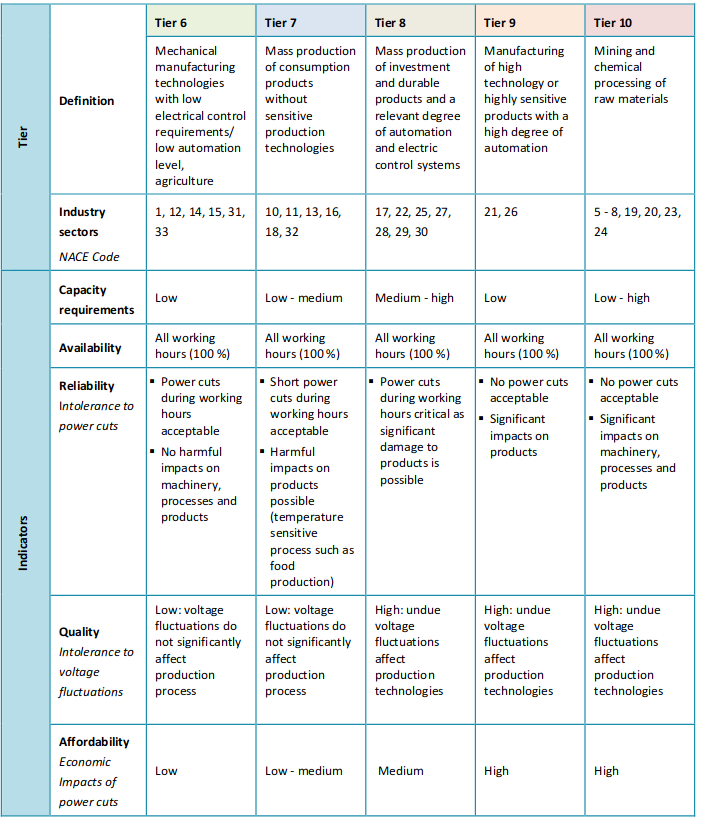Click here to register!
Proposal for Extending the Multi-Tier Framework
Overview
This article examines the Multi-Tier Framework, the methodology for monitoring a demand-oriented energy supply that includes the significant role of productive use of sustainable energies in both the commercial and industrial sectors in developing and emerging economies. It summarizes the main findings of the publication “Next level sustainable energy provision in line with people’s needs. A proposal for extending the Multi-Tier Framework for monitoring the SDG7”. https://www.isi.fraunhofer.de/content/dam/isi/dokumente/ccx/Review-of-the-monitoring-framework/Fraunhofer-ISI_SDG7-Review_Study_full_report.pdf
The study, which was commissioned by the Energy Sector Project (E-KORE), was conducted by the Fraunhofer Institute for System and Innovation Research (FhG-ISI) in cooperation with the Institute for Resource Efficiency and Energy Strategies (IREES). The analysis aimed for an extended Along with the initiative Green people’s energy for Africa, the study thus supports BMZ’s aim to improve energy access for people in rural areas to create local jobs and economic activity to strengthen sustainable economic development.[1]
Definitions
The Multi-Tier Framework is a well-established approach for tracking energy supply related progress in the SDG7 context. With regard to electricity access, the framework focuses mainly on household energy demand requirements and has only a limited applicability to productive uses of electricity, such as small-scale family businesses.[1]
Productive use of electricity can be defined as the utilisation of electricity for activities which generate a monetary value or, based on a broader definition of the term, contribute to an enhanced productivity or increased welfare of the affected population. [2][3]
Currently, MTF tier scale is not sufficient to consider electricity access requirements of small-and medium-sized manufacturing enterprises, communal cooperatives, larger industrial businesses or commercial and industrial parks. It focuses mainly on household energy demand. Measuring progress of electricity access conditions with regard to productive uses is, however, essential for the SDG7 goal, since only the settlement and development of enterprises leads to an economic perspective in the regions. Whereas productive uses of manufacturing and process industries are not considered yet, the household scale is rather fragmented and at a low level of ambition.[1]
Suggestions for the Mulit-Tier Framework revision
The study suggests to revise and extend the current MTF as follows:[1]
- Revising the current tiers for the household sector in order to represent essential development steps from basic household applications and requirements for clean (electric) cooking and cooling applications to small-sized commercial activities.
- Allow for a closer link between climate change policies and strategies for economic development and sustainable energy supply to safeguard that the electricity requirements on all tiers can be met with needs-oriented butenvironment-friendly energy solutions. Here, especially the application of decentralized renewable energy solutions plays a major role.
- Adding 5 additional tiers for productive uses covering electricity access requirements of a broad range of business activities ranging from processing of agricultural products to highly sensitive and energy-intensive production processes.
Figure 1: Overview over the proposed revision of the current MTF[1]
Instead of applying different MTF matrices for households and productive uses, the proposed framework represents an integrated scale covering the electricity access requirements of households, various commercial or manufacturing activities and industrial processes (see Figure).
The approach generates a tool to evaluate electricity access not only against the background of the current underdeveloped industrial structures as present in many developing and emerging countries but also from a forward-looking, development perspective.
Proposed Additional Tiers 6-10
The newly developed tiers for productive uses are categorized according to business activities and production processes from which specific electricity supply requirements result:[1]
- Tier 6: Mechanical manufacturing technologies with low electrical control requirements and a low automation level including agriculture;
- Tier 7: Mass production of consumption products without sensitive production technologies;
- Tier 8 Mass production of investment goods and durable products with a relevant degree of automation and electric control systems;
- Tier 9: Manufacturing of high technology or highly sensitive products with a high degree of automation;
- Tier 10 Mining and chemical processing of raw materials with a very high energy demand.
Examples for electricity access requirements defined by each of the tiers can be referred to major industries in developing countries.
Figure 2: Proposal for the extension of the Multi-Tier Framework for productive uses[1]
References
- ↑ 1.0 1.1 1.2 1.3 1.4 1.5 1.6 Boie I., Steinbach J., Christ C., Ashley-Belbin, N., Lösch, O., Denishchenkova, A, Ordonez J. (2018). Next level sustainable energy provision in line with people’s needs - A proposal for extending the Multi-Tier Framework for monitoring the SDG7. Fraunhofer ISI, IREES GmbH commissioned by GIZ and supported by the Federal Ministry for Economic Cooperation and Development (BMZ), Karlsruhe, Germany.
- ↑ Brüderle, A., M. Bodenheimer (2011): Productive Use of Energy (PRODUSE), Eschborn. A Manual for Electrification Practitioners. http://www.produse.org/index.php?lang=eng&page=15&gallery=32
- ↑ Kapadia, K. (2014): Productive uses of renewable energy, Washington DC. A Review of Four Bank-GEF Projects. http://www.martinot.info/Kapadia_WB.pdf
Further Information
- Global Tracking Framework for Measuring Energy Access
- Portal:Energy Access
- Estimating energy demand of the energy poor
- PRODUSE: Brüderle, A., M. Bodenheimer (2011): Productive Use of Energy (PRODUSE), A Manual for Electrification Practitioners.





















